Temporality and Ideology: Qualities of Motion in Seventeenth-Century French Music
By Susan McClary
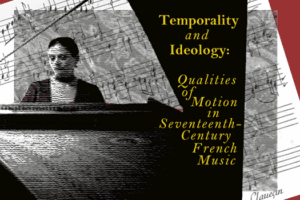
In a classic essay from 1973, art historian Michael Fried focused on a quality he had discerned in French eighteenth-century painting—a quality he called “absorption” (Fried, “Absorption” 139-77).[1]See also Fried Absorption. Fried observes that “there had been a tradition of absorptive painting, one whose almost universal efflorescence in the seventeenth century was everywhere followed by … Continue reading The paintings he examines in the course of the article depict individuals so immersed in meditation that they seem withdrawn from the world. Those artists who excelled in this  genre rarely chose heroic figures as their subjects; Jean-Baptiste Greuze, for instance, often preferred to present pretty children quietly pondering their dead canaries or gazing in distraction away from their books. [Greuze’s Jeune Fille qui pleure la mort de son oiseau pictured] Today such paintings may strike viewers as precious and sentimental—certainly not the stuff to which one would turn in reconstructing socio-political history. Indeed, these works, much loved during their own moment, have long been dismissed by many critics as kitsch. Yet by interrogating this quality of absorption rather than the manifest content of the canvases, Fried identifies an elusive but persistent element for the period under consideration—the kind of element Raymond Williams referred to as a “structure of feeling”:
genre rarely chose heroic figures as their subjects; Jean-Baptiste Greuze, for instance, often preferred to present pretty children quietly pondering their dead canaries or gazing in distraction away from their books. [Greuze’s Jeune Fille qui pleure la mort de son oiseau pictured] Today such paintings may strike viewers as precious and sentimental—certainly not the stuff to which one would turn in reconstructing socio-political history. Indeed, these works, much loved during their own moment, have long been dismissed by many critics as kitsch. Yet by interrogating this quality of absorption rather than the manifest content of the canvases, Fried identifies an elusive but persistent element for the period under consideration—the kind of element Raymond Williams referred to as a “structure of feeling”:
For what we are defining is a particular quality of social experience and relationship, historically distinct from other particular qualities, which gives the sense of a generation or of a period. The relations between this quality and the other specifying historical marks of changing institutions, formations, and beliefs, and beyond these the changing social and economic relations between and within classes, are again an open question: that is to say, a set of specific historical questions [. . .] We are talking about characteristic elements of impulse, restraint, and tone; specifically affective elements of consciousness and relationships: not feeling against thought, but thought as felt and feeling as thought: practical consciousness of a present kind, in a living and interrelating continuity. (131-32)
I encountered Fried’s article when I was seeking to 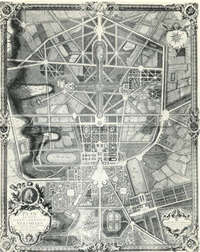 understand a peculiar quality in French music of the ancien régime—a quality that seems designed to induce something like absorption in the listener, a quality of stillness in which consciousness hovers suspended outside linear time. As it turns out, Fried’s absorption is but one of a very large cluster of privileged images and metaphors prevalent in France during the seventeenth and eighteenth centuries that converge around the ideal of timelessness: I would include here the neoplatonic geometry that undergirds everything from landscape design to ballroom dance at Versailles [General plan of André Le Nôtre’s gardens at Versailles pictured], the obsession with Arcadian themes that pervades court life and its art, the warnings against thinking about the future in Jansenist theology, the Quietist definition of ecstasy as a state of utter desirelessness.
understand a peculiar quality in French music of the ancien régime—a quality that seems designed to induce something like absorption in the listener, a quality of stillness in which consciousness hovers suspended outside linear time. As it turns out, Fried’s absorption is but one of a very large cluster of privileged images and metaphors prevalent in France during the seventeenth and eighteenth centuries that converge around the ideal of timelessness: I would include here the neoplatonic geometry that undergirds everything from landscape design to ballroom dance at Versailles [General plan of André Le Nôtre’s gardens at Versailles pictured], the obsession with Arcadian themes that pervades court life and its art, the warnings against thinking about the future in Jansenist theology, the Quietist definition of ecstasy as a state of utter desirelessness.
To the consternation of historians who like to keep their categories separate, these images come from a wide variety of cultural domains, some of them (for instance, the Absolutist court and the Jansenist philosophers of Port Royal) explicitly antagonistic. Moreover, they appear throughout the seventeenth and eighteenth centuries: a very long span of time during which many radical ideological and cultural changes occurred.[2]Gordon Pocock justifies a similar account of the longue durée in Pocock: {. . . neoclassicism as} a doctrine which flourished in such different social and intellectual contexts, beginning in … Continue reading I will return later in this essay for a more detailed discussion of these problems. But first I wish to consider briefly the music that first motivated this line of inquiry.
In my experience as a coach of early-music performance, the seventeenth-century Frenchrepertory presents more acute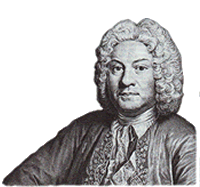 challenges to most present-day musicians than any other. Heinrich Schütz’s complex modal allegories or Girolamo Frescobaldi’s erratic toccatas may present them with temporary obstacles, but these gradually become accessible through the rhetorical sensibilities performers bring with them from later music. The French baroque, however, stops them dead in their tracks; François Couperin [pictured, right] taunts them from across the centuries when he boasts in L’Art de toucher le clavecin(1716) that “foreigners play our music less well than we do theirs.”[3]François Couperin, ‘L’Art de toucher le Clavecin (1716), the paragraph just before the heading “Examinons donc d’où vient cette contrarieté!” Yet most performers, before they will accept Couperin’s chauvinistic diagnosis for their puzzlement, prefer to reverse the blame, to dismiss the music itself as incompetent.
challenges to most present-day musicians than any other. Heinrich Schütz’s complex modal allegories or Girolamo Frescobaldi’s erratic toccatas may present them with temporary obstacles, but these gradually become accessible through the rhetorical sensibilities performers bring with them from later music. The French baroque, however, stops them dead in their tracks; François Couperin [pictured, right] taunts them from across the centuries when he boasts in L’Art de toucher le clavecin(1716) that “foreigners play our music less well than we do theirs.”[3]François Couperin, ‘L’Art de toucher le Clavecin (1716), the paragraph just before the heading “Examinons donc d’où vient cette contrarieté!” Yet most performers, before they will accept Couperin’s chauvinistic diagnosis for their puzzlement, prefer to reverse the blame, to dismiss the music itself as incompetent.
Oddly enough, this assessment underlies a good many of our  official musicological accounts of this music. Of those who have written on seventeenth-century French music, only David Fuller seems to me to have grappled sympathetically with how it produces its effects.[4]See, for instance, Fuller, “Chambonnière”; Fuller, “French Harpsichord Playing”; Fuller “’Sous les doits’.” I wish to thank Professor Fuller for sharing with me some of his … Continue reading But most scholars—even those who create elaborate catalogues, exhaustive archival documentation, and detailed histories—go on summarily to dismiss the materials in question as unworthy of serious musical attention. In his introduction to a book devoted to Lully [pictured, left], for instance, Paul Henry Lang writes (with extravagantly feminized tropes):
official musicological accounts of this music. Of those who have written on seventeenth-century French music, only David Fuller seems to me to have grappled sympathetically with how it produces its effects.[4]See, for instance, Fuller, “Chambonnière”; Fuller, “French Harpsichord Playing”; Fuller “’Sous les doits’.” I wish to thank Professor Fuller for sharing with me some of his … Continue reading But most scholars—even those who create elaborate catalogues, exhaustive archival documentation, and detailed histories—go on summarily to dismiss the materials in question as unworthy of serious musical attention. In his introduction to a book devoted to Lully [pictured, left], for instance, Paul Henry Lang writes (with extravagantly feminized tropes):
The music all these composers cultivated was in the sign of the dance, so congenial to the French, with its neat little forms, pregnant rhythms, great surface attraction, and in tone and structure so much in harmony with the spirit of the age. This music, though slight and short-breathed, was elegant and so different from any other that the whole of Europe became enamored of it. (1)
Similarly, James R. Anthony, in his French Baroque Music (long the definitive book on this repertory), damns with the faintest of praise one of its most characteristic genres:
In summary, French lute music of the seventeenth century is mannered, precious, even decadent; its melodies are surcharged with ornaments, its rhythms fussy, its harmony often aimless, and its texture without unity. Yet at the same time, it is never pretentious, it never demands more from the instrument than the instrument can give. In its own fragile way, it is honest to itself. (243)
We must keep in mind, however, that the Absolutist rulers who commissioned and listened to this music had access to the very best artistic talents money could buy. It is not likely that Louis XIV [pictured] simply tolerated mediocrity in his compositional staff; indeed, we know that he intervened at every level of cultural production and even participated personally in auditions for new orchestral musicians. If this music now falls on figuratively deaf ears, it seems to have satisfied precisely what its highly discriminating makers and patrons required of it.
Louis XIV [pictured] simply tolerated mediocrity in his compositional staff; indeed, we know that he intervened at every level of cultural production and even participated personally in auditions for new orchestral musicians. If this music now falls on figuratively deaf ears, it seems to have satisfied precisely what its highly discriminating makers and patrons required of it.
As the quotations above indicate, today’s musicians encountering French seventeenth-century music often experience it chiefly in terms of lack: they listen in vain for teleological tonal progressions (“its harmony often aimless”), patterns of motivic reiteration (“its texture without unity”), or imitative counterpoint—the very ingredients we have learned through our theoretical training to notice. Instead, this music arrests the attention with an ornament here, a sudden flurry and cessation of activity there, making it difficult or impossible to play the games of speculation and anticipation we usually bring to music of this and subsequent periods.
Confronted by what we take as manifestations of absence, we may hear this music as relatively arbitrary—as a series of events connected (if at all) only on a moment-by-moment basis. In phenomenological terms, it sounds static rather than dynamic. Yet most courtiers and artists during the ancien régime clearly preferred this music to its alternatives. Consequently, historians of seventeenth-century French culture face the difficult task of converting all those negatives into positive attributes. What kinds of rewards did this music offer its devotees? What structures of feeling did it reinforce?
We might, of course, turn directly to the polemics of the time, in which Francophile connoisseurs sought to justify their predilections. In their attempts at pinpointing the essence of French music, they buttressed their documents with words such as bon goût, plaisir, and raison (good taste, pleasure, reason)—words obviously freighted with a great deal of cultural prestige. But those words speak meaningfully only to insiders who already count themselves aficionados; the rest of us must ask: whose taste? which pleasures? what version of reason?
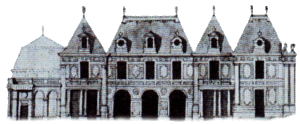
I have selected as an example Jean Henry D’Anglebert’s Tombeau de M.r de Chambonnières, from his print of 1689 (109-110). I acknowledge the danger of single examples: I too can produce lists of pieces that behave otherwise—most obviously, the unmeasured preludes that flourished during this period in the hands of Louis Couperin, Elisabeth-Claude Jacquet de la Guerre, and D’Anglebert himself, as well as the hybrids produced by composers such as Marc-Antoine Charpentier or François Couperin who self-consciously trafficked in Italianate styles. I know, moreover, that the genre of the tombeau virtually demands an elegiac, introspective quality. Yet D’Anglebert [pictured right] exemplifies in his tombeau (and in most of his pieces) so many of the points I wish to make, and he does so with what seems to me such beauty and skill, that I hope to avoid the charge that the music itself is inept, even if it works according to premises far removed from the ones within which we usually operate.
otherwise—most obviously, the unmeasured preludes that flourished during this period in the hands of Louis Couperin, Elisabeth-Claude Jacquet de la Guerre, and D’Anglebert himself, as well as the hybrids produced by composers such as Marc-Antoine Charpentier or François Couperin who self-consciously trafficked in Italianate styles. I know, moreover, that the genre of the tombeau virtually demands an elegiac, introspective quality. Yet D’Anglebert [pictured right] exemplifies in his tombeau (and in most of his pieces) so many of the points I wish to make, and he does so with what seems to me such beauty and skill, that I hope to avoid the charge that the music itself is inept, even if it works according to premises far removed from the ones within which we usually operate.
Let me begin with the usual series of negatives. First, D’Anglebert’s tombeau displays no imitative counterpoint of the sort we like to celebrate in Bach. (Note, however, that if we were to turn the page in the print we would find a set of five fugues on a single subject. D’Anglebert was, in other words, fully capable of contrapuntal complexity, even if he does not showcase it in most of his work.)
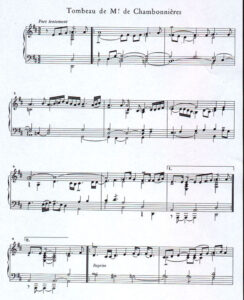
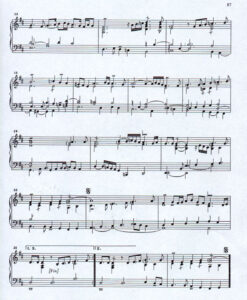
Finally, the piece never really modulates. Binary dance forms tend to adhere closely to conservative harmonic conventions, but this example does not even establish its dominant as a secondary key at the end of the first half. Twice D’Anglebert implies the possibility of moving to the subdominant (both mm. 2-4 and 17-19 gesture toward G major), but neither passage concludes with a cadence. The key of A minor becomes a viable destination in mm. 14-15, but the would-be cadence on A never materializes. In the final analysis, the tombeau remains in D major from start to finish.Second, this tombeau does not employ melodic motives to pull the various parts of the piece together; instead, the rhythmic groupings of the surface constantly shift. To be sure, as a gaillarde,[5]Two other compositions labeled “gaillarde” appear in D’Anglebert’s print, one virtually a transposition of the tombeau de M.r de Chambonnières into the minor mode (see 81-82; the other … Continue reading it offers the regularity of dance steps: the piece guarantees at least the rational structure of a slow triple meter with stresses on beats 3 and 1, and it thus choreographs the body in accordance with a neoplatonic matrix. But the listener cannot predict when a metric unit will contain a surfeit of ornamental notes (e.g., the middle beat of m. 3) or when it will hover with virtually no activity.
Yet this series of negatives seems to me less an indictment of D’Anglebert’s skill as a composer than of our analytical habits, which were designed for illuminating particular repertories but then applied willy-nilly as universal standards to all music. I do find it noteworthy that D’Anglebert does not utilize imitative counterpoint, unifying motives, or a progressive modulatory schema in this tombeau. But his refusal of these devices—all of which he employs in other pieces—leads me to ask what these devices usually accomplish.
If we turn to the dance suites of Bach or the dance-types (allemandes, gigues) in which the French also typically made use of imitative counterpoint, we find that this device produces relatively long rhythmic groupings, the reiteration of which invites listeners to project into the future.[6]See, for instance, McClary Conventional Wisdom, chapter 3. As soon as the second voice enters to repeat what we have just heard in the first, we can leap forward in our imaginations to anticipate what will happen next. To be sure, the specific engagement between voices may offer us delight. Yet as soon as the imitation begins, we know from past experience with such techniques to jump ahead in time and start speculating. Something similar occurs with motivic play: when a composer indicates that a two-beat-long motive will saturate the texture of a piece, the listener quickly assumes a particular way of parsing out time.[7]For more on the very sophisticated ways listeners orient themselves with respect to music, see Zbikowski. Of course, motives produce a sense of identity, organic relatedness, and much else as well. But they also greatly influence our perception of temporality.[8]See McClary “Temp Work.”
As does the rhetorical version of modulation that pervades contemporaneous Italian music, which works on the basis of instilled, heightened, and fulfilled desire. Developed as a means of expanding the simple linear formulas of modal practice, this set of procedures sustains each pillar of the background structure by deferring arrivals, barely granting each implied cadence before rushing off toward the next. Each moment serves principally to whet the appetite for its successor, maximizing a headlong race into the future—the immediate future of the next modulatory arrival, the final destination of the return to tonic.[9]See McClary Conventional Wisdom, chapters 1 and 3 for discussions of early Italian tonality.
It is this element of multi-leveled goal orientation, I would argue, that people unaccustomed to French seventeenth-century music miss the most: to the extent that progressive tonality counts as “how music is supposed to work,” its absence spells pure and simple incompetence. Yet if we take seriously the choices made by D’Anglebert and his colleagues, we can glean insights into a society quite alien from the one that gave our own dominant tradition not only its compositional techniques, but also its sense of being. For D’Anglebert worked within a culture that for a wide variety of reasons wished to promote sensibilities of timelessness.
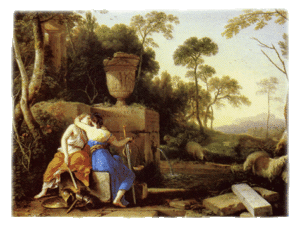
Laurent de La Hyre, “The Kiss of Peace and Justice”
But how precisely does a composer go about producing such effects? Music by its very nature unfolds through time; of all media it would seem the most resistant to the project of conveying immobility. Put briefly, D’Anglebert’s task is to produce an experience of time in which the listener is absorbed by each present instant. He is obliged to satisfy the rules of orderly succession (the much vaunted raison) as he moves from moment to moment: the transgression of fundamental propriety would undermine the idyllic security of this prolonged stasis. He may even group together a couple of measures in a quasi-causal conspiracy, as in the case of the implied modulations, although none of these actually comes to fruition. Yet—in contrast with superficially similar strategies in Italian music of the time—those missed cadences do not spark the rhetorical effects of disappointment or frustration; rather the relatively low level of anticipation involved produces merely a bittersweet inconclusiveness. Gradually we learn from this music not to bother with future-oriented thought, but to embrace the serenity of each new configuration as it arises.
D’Anglebert thus needs to make every moment sufficiently full that we can desire nothing more, so that the attention moves on to the next instance of plenitude only with reluctance. And this he accomplishes in large part through his highly refined negotiations between two different conceptions of rhythmic activity: what the French referred to as Mesure and Mouvement. Couperin wrote that whereas “Mesure defines the number and equality of the beats,” “Cadence or Mouvement is properly the spirit and soul that it is necessary to add” (qtd. In Scheibert 40-41). Bénigne de Bacilly further explains these important qualities thus:
Mouvement [. . .] is a certain quality that gives soul to the song, and that it is called Mouvement because it stirs up, I may say it excites, the listeners’ attention, in the same way as do those who are the most rebellious in harmony [. . .] it inspires in hearts such passion as the singer wishes to create, principally that of tenderness [. . .] I don’t doubt at all that the variety of Mesure, whether quick or slow, contributes a great deal to the expression of the song. But there is certainly another quality, more refined and more spiritual, that always holds the listener attentive and ensures that the song is less tedious. It is the Mouvement that makes the most of a mediocre voice, making it better than a very beautiful voice without expression. (qtd. In Scheibert, 40-41)
We might say that listeners can follow quite easily the raison of the tombeau’s Mesure (its metric structure), but would be hard pressed to anticipate the bon goût of its Mouvement (its particular way of inhabiting each successive beat). Couperin and Bacilly write primarily for performers, and they point to something beyond simple metrical accuracy for which players or singers must take responsibility. To the extent that a score such as D’Anglebert’s represents a kind of recorded improvisation, we may discern at least some of the ways in which he composes in the effects so treasured by his contemporaries—the effects conducive to absorption.
One of D’Anglebert’s principal strategies for playing Mouvement against Mesure is his lavish deployment 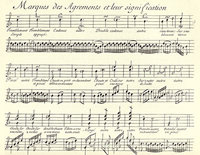 of ever-changing ornaments. Unlike Italian ornaments, which almost always lead forward impulsively to the next event, French agréments [pictured (click to enlarge)] serve to ground any rhythmic excess that may have accumulated by securing the weight onto the strong beats, the markers of Mesure; the tension/release mechanisms that animate the music occur on the very local level of the half note. But even as the arrival on the beat reliably anchors the dance step, the agréments draw the ear down into the intricacies of those slight delays that flirt with the self-evident main pitch, thus sustaining a crucial quality of hovering and allowing for the constantly replenished novelty of Mouvement.
of ever-changing ornaments. Unlike Italian ornaments, which almost always lead forward impulsively to the next event, French agréments [pictured (click to enlarge)] serve to ground any rhythmic excess that may have accumulated by securing the weight onto the strong beats, the markers of Mesure; the tension/release mechanisms that animate the music occur on the very local level of the half note. But even as the arrival on the beat reliably anchors the dance step, the agréments draw the ear down into the intricacies of those slight delays that flirt with the self-evident main pitch, thus sustaining a crucial quality of hovering and allowing for the constantly replenished novelty of Mouvement.
D’Anglebert also ensures that we will expect something beyond the luxury of the instant at hand through judiciously arranged harmonic dissonances, for he saturates the surface of his tombeau with lengthy suspensions and anticipations. These operate much like a series of locks on a canal: they break down what could otherwise be an abrupt shift into tiny increments that release the pressure only gradually. [Versailles floor plan pictured]
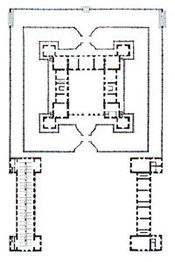
Thus the opening trajectory—a descent from tonic (D) down to the mediant (F#) in the bass—is both urged along by a tenor line that applies the pressure of 2-3 suspensions at irregular intervals and also delayed by the bass’s seeming reluctance to part with each of its pitches (note, for instance, the port de voix that creates a pull on its move to C# in m. 1). No sooner is the basic trajectory of the progression clear to the ear (with the descent to C natural in m. 1 and dissonance added at the beginning of the next bar) than D’Anglebert begins playing with rates of motion: observe the way he sustains that dissonance for two full beats in m. 2—enhancing the poignancy of the moment through the feathery mordent of the middle voice marking the second pulse. But as the bass descends to B (such a big deal for such an obvious move!), the tenor quickens its pace and coaxes the ear into the even richer sonority of m. 3—suspended in turn with a wistful melisma in the soprano. Even the arrival on F#, destined for the downbeat of m. 4, lingers so that the soprano reaches its melodic goal alone and in tension against the bass. Finally, the bass slips down to produce the desired pitch, though on the off-beat as a mere afterthought, and the right hand supplies its downward arpeggiation of the first-inversion tonic sonority—the affirmation of a quasi-caesura—over a rhythmic void in the bass.
| View Susan McClary’s performance of D’Anglebert’s Tombeau de M.r de Chambonnières (56K or faster required) |
I don’t want to bore you with an inchworm’s eye view of this piece. Yet D’Anglebert focuses our attention at precisely this level—on the fact of that exquisite mordent in m. 2, on the sudden awakening and repositioning that follows, on the swirl of circular activity in m. 3, on the non-simultaneity of arrivals in m. 4. Consequently, one shouldn’t even think about playing a piece like this unless one is willing to savor to the utmost every detail in turn. Harpsichordist Lisa Crawford used to smile with delight at her hands when they played these pieces, as though they were adorable pets who were frolicking of their own accord.
Compare the method behind my description of D’Anglebert’s opening passage with Denis Diderot’s celebrated review of Greuze’s painting “Young Girl Mourning her Dead Bird”[10]Original source: Denis Diderot, “Salon de 1765,” in Oeuvres esthétiques, ed. Paul Vernière (Paris: Garnier, 1959), 533. Diderot writes, of course, at a very different moment in French history. … Continue reading [pictured below]
The pretty elegy! The charming poem! [. . .] Delicious painting! [. . .] Oh, the pretty hand! The pretty hand! The beautiful arm! Notice the truthful details of these fingers; and these dimples, and this softness, and this blushing tint with which the pressure of the head has colored the tips of these delicate fingers, and the charm of all this [. . .] One would move closer to this hand in order to kiss it, if one didn’t respect this child and her pain [. . .] This kerchief is thrown on the neck in such a fashion! So supple and light! When one sees this detail one says, Delicious! If one stops to look at it, or returns to it, one exclaims: Delicious! delicious! (qtd. in Brooks 35-7)
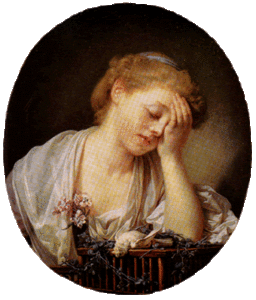
Or compare it with this eyewitness account of Chambonnière’s performances of his music: “Every time he played a piece he incorporated new beauties with ports-de-voix, passages, and different agréments, with doubles cadences. In a word, he so varied them with all these different beauties that he continually revealed new charms” (qtd. in Fuller “’Sous le doits’” 196). Or read Charles Rosen’s exquisite analysis of how one of D’Anglebert’s contemporaries—the poet and fabulist Jean de La Fontaine—manipulated minute shadings in French vowel sounds to produce his unparalleled effects of aural patterning (38-46).
To focus on—indeed, to fetishize—each moment of a piece goes quite contrary to our training as analysts and as musicians; philosophically we descend from an anti-French tradition of German Kultur that insisted on the moral virtue of structural essence in counterdistinction to the sensual surfaces of French Civilisation,[11]See the theoretical and historical discussion of Kultur versus Civilisation in Elias The History of Manners, chapter 1. See also McClary “Unruly Passions,” 85-112. and we learn to brush away such details in order to get at a composition’s formal truth. Accordingly, D’Anglebert’s processes may well breed impatience to get on with things and not to dither about where exactly to locate the downward arpeggio demanded in the beat that serves as a pick-up to the first full measure. We might be tempted to mutter in exasperation: “It’s a tonic triad—get over it!” But that beat (by far the most difficult to execute in the entire piece) sets the atmosphere for everything that follows: the appoggiatura (itself elaborately embellished) that delays the arrival on A before the arpeggio can commence already puts a nostalgic tug against the necessity of moving forward through time, and the eloquent repetition of A just before m. 1 produces a gesture of stoic resolve following the collapse performed by the arpeggio. Delicious! delicious!
A telling feature of this music, once it has seduced one into its phenomenological web, is that the performer actually wants to play the repeats—even the invitation at the end of each dance to recommence from the beginning. The longing to sustain this out-of-time state becomes almost a physical necessity, and 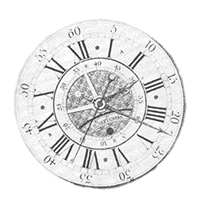 one dives back in to revisit each exquisite moment as soon as one reaches the double-bar. After a summer of playing only this music and noticing in myself this odd compulsion to take repeats, I assumed I would bring this new-found reflex back with me when I played Bach. But no: even the most Francophilic of Bach’s dances pushes inexorably forward through its series of destinations. Taking the repeats in Bach is, to be sure, always instructive, for we cannot truly grasp how he got from one place to another in a single hearing. Still, to go back and do it all over again feels a bit like turning back the clock, like a betrayal of the narrative impulse that propels Bach’s music onward.[12]See again McClary Conventional Wisdom, chapter 3.
one dives back in to revisit each exquisite moment as soon as one reaches the double-bar. After a summer of playing only this music and noticing in myself this odd compulsion to take repeats, I assumed I would bring this new-found reflex back with me when I played Bach. But no: even the most Francophilic of Bach’s dances pushes inexorably forward through its series of destinations. Taking the repeats in Bach is, to be sure, always instructive, for we cannot truly grasp how he got from one place to another in a single hearing. Still, to go back and do it all over again feels a bit like turning back the clock, like a betrayal of the narrative impulse that propels Bach’s music onward.[12]See again McClary Conventional Wisdom, chapter 3.
When this Italianate impulse begins to infiltrate François Couperin’s music, he often marks it programmatically as a special effect. See, for instance, the opening movement (an allemande) of his Second Order, titled “La Laborieuse” (the laborious), in which a two-beat-long motive works hard to achieve every twist and turn along the course of the piece. Or, more famously, “Les Baricades Mistèrieuse” (mysterious barricades, from the Sixth Order): a rondeau movement that enacts in its third couplet, however gently, the sense of striving to overcome invisible obstacles typical of the Italo-German version of tonality. It is as though the premises of such techniques—the very basis of what pass in Bach as “purely musical”—demand some extramusical explanation within the French context. Interestingly, the one movement Couperin named after himself, “La Couperin” in the Twenty-first Order, identifies through its procedures with the Italian style.
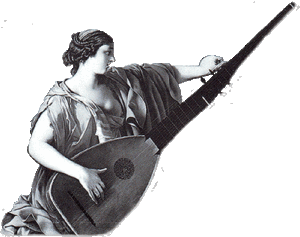
The reader has no doubt noticed that I am once again committing the crime I think of as “effing the ineffable”: that is, translating into words the kinds of experiences that music can render so effortlessly and that speech does so clumsily and ineffectively. I have three reasons for doing so, however, two of which I have indicated throughout my discussion: first, that performers often require extensive reorientation of this sort before they can make any sense of this music; second, that coming to terms with the French repertory can lead us to reexamine the cultural premises of the most basic units of our analytical methods and to take seriously elements such as this elusive quality.
But I want to concentrate for the rest of my discussion on my third reason—namely, history. Historians such as Hayden White sometimes implore musicologists to give back to the discipline of history the kinds of information to which musicians have special access. Too often, we restrict ourselves to the modes of evidence available to other historians while neglecting those issues to which they look to us, usually in vain. Yet scholars who cannot read a note of music can produce inventories of archives, comparisons among verbal documents, or accounts of various moments of critical reception. They cannot, however, address how music itself participates as a cultural medium to articulate structures of feeling.
Let me begin with some of the common explanations for why much French seventeenth-century music works in the ways I have described. Some simply assume the mediocrity of the music, as the products of talentless composers. And many assign the blame for this abysmal absence of talent at the French court to Jean-Baptiste Lully, who exercised a ruthless monopoly over composition, driving would-be competitors to seek employment outside France and leaving behind only those who posed no challenges. Paul Henry Lang writes concerning Lully: “In this ascent to a commanding position he deftly used everyone from the king down. The lettres patentes and the privilèges he secured from the king were so outrageous that they could not have stood the slightest legal scrutiny, but they could not be scrutinized because they came directly from the king. This adroit manipulator did succeed in becoming the virtual dictator of French musical life” (2).[13]See also Rosen, “The Fabulous La Fontaine” for a discussion of how talented artists fled France during this period because of Louis’s ruthless favoritism.
But many political and cultural historians (Robert Isherwood, Norbert Elias, Michel Foucault, Kathryn A. Hoffmann) have pointed to the ideological centrality of neoplatonic ideals for the perpetuation of the Absolutist state. Such critics understand seventeenth-century French cultural forms not as inept but as exceptionally powerful; they concentrate on how these media created the illusion of an eternal NOW so surfeited with pleasures and images of perfect order that thoughts of change never even had the chance to arise. In theory at least, Louis XIV arranged the daily lives of the nobility so as to distract them from fomenting rebellions such as the Fronde, to suspend them in an Arcadia of endless delights, in a condition of busy immobility. Hoffmann opens her book with “The society of pleasures…was a reverie of power where the logic of pleasure always contained the trap of violent oppression, where desire and force, pleasure and knowledge, the caress and the chains of subservience always informed each other in strange couplings” (1); and Isherwood concludes his study with the sentence: “Louis XIV made music the handmaiden of the politics of absolutism” (352).[14]I pursue this line of argumentation in McClary “Unruly Passions.”
Thus we could explain the music as the pragmatic means to an autocratic end: the deliberate anaesthetizing of a potentially restless group of subjects. The geometrical gardens at Versailles, the carefully executed divertissements, the highly regulated dance maneuvers [Louis Pécour’s La Bourée d’Achille pictured], 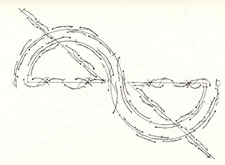 the complex etiquette of courtly manners, and many aspects of the music were deliberately designed to produce these political effects, to lull aristocrats into habits of activity-filled oblivion; in the words of a cynical contemporary critic: “Let the people slumber away in their festivities, in their spectacles” (qtd. in Burke 6).[15]“Laisser le peuple s’endormir dans les fêtes, dans les spectacles.” J. La Bruyère, Les Caractères, 1688. In Society of Pleasures, Hoffmann traces in texts of this time the many recurrent … Continue reading I always marvel at accounts of French baroque music that somehow neglect to mention any of these issues; we should never minimize the efforts at social engineering that lent support to these cultural practices.
the complex etiquette of courtly manners, and many aspects of the music were deliberately designed to produce these political effects, to lull aristocrats into habits of activity-filled oblivion; in the words of a cynical contemporary critic: “Let the people slumber away in their festivities, in their spectacles” (qtd. in Burke 6).[15]“Laisser le peuple s’endormir dans les fêtes, dans les spectacles.” J. La Bruyère, Les Caractères, 1688. In Society of Pleasures, Hoffmann traces in texts of this time the many recurrent … Continue reading I always marvel at accounts of French baroque music that somehow neglect to mention any of these issues; we should never minimize the efforts at social engineering that lent support to these cultural practices.
Yet I hate to fall back on a monolithic Adornoesque explanation that appeals solely to false consciousness. For if political establishments and their intentions must form part—even a large part—of the picture, they cannot account for the allure of the imagery, the material complexity of the practices, the ideals embodied and enacted through these processes. Moreover, a state, however powerful, cannot bring into being a viable structure of feeling purely by fiat.[16]For critiques of the explanation of this culture as simply imposed from above, see again Hoffmann and also Dewald, Aristocratic Experience and the Origins of Modern Culture. At best it can privilege some qualities that seem consonant with its priorities and try to suppress others—which is, of course, precisely what happened under Louis XIV. But this mode of being has to have had broad-based support, had to have made sense and genuinely counted as pleasurable for it to work, even at the political level.
As it happens, this sense of timelessness was valued not only by the centers of power in France, but also by many of those disenfranchised by Absolutism. In his classic study The Hidden God, Lucien Goldmann argues that the Port Royal philosophers advocated withdrawal from the world in part as a way of coping with an eroded sense of political agency; he shows how they aspired to an ideal of attentive motionlessness while discouraging future-oriented thought and beliefs in progress.[17]For a more recent political interrogation of Racine and his relation to power, see Hoffmann, Chapter 2. Martin de Barcos (1600-78) wrote, for instance:
Thoughts of the future are a dangerous and clever temptation of the Evil One, contrary to the spirit of the Gospel, and capable of ruining everything if not resisted; they must be rejected without even a first glance, since God’s word tells us not only to take no thought for the morrow in things temporal but also in things spiritual, and it is these which hang much more on His will. (qtd. in Goldmann, 34)
Far from anticipating the advent of Enlightenment habits of thought, this philosophy recalls the sublime passivity advocated in the Biblical Parable of the Lilies in Matthew 6: “Consider the lilies of the field, how they grow; they toil not, neither do they spin; And yet I say unto you, That even Solomon in all his glory was not arrayed like one of these.” Barcos’s more famous colleague Blaise Pascal likewise wrestled with skepticism concerning agency in a world bounded by Absolutist rule: “We desire truth and find in ourselves nothing but uncertainty. We seek happiness and find only misery and death. We are incapable of not desiring truth and happiness and are incapable of either certainty or happiness. We have been left with this desire as much as a punishment as to make us feel from where we have fallen” (qtd. in Melzer 86).[18]Orginal source: Blaise Pascal, Pensées, ed. Philippe Sellier (Paris: Mercure de France, 1976), fragment 20. {“Nous souhaitons la vérité et ne trouvons en nous qu’incertitude. Nous recherchons … Continue reading
An entirely different religious domain, that of the Quietist mystics, diverged in many important ways from the theology of Port Royal. Yet they too advocated withdrawal from time. St. Francis de Sales (1567-1622), for instance, wrote concerning “The Prayer of Quiet”:
The soul, then, being thus inwardly recollected in God or before God, now and then becomes so sweetly attentive to the goodness of her well-beloved, that her attention seems not to her to be attention, so purely and delicately is it exercised; as it happens to certain rivers, which glide so calmly and smoothly that beholders and such as float upon them, seem neither to see nor feel any motion, because the waters are not seen to ripple or flow at all.
Now this repose sometimes goes so deep in its tranquillity, that the whole soul and all its powers fall as it were asleep, and make no movement nor action whatever except the will alone, and even this does no more than receive the delight and satisfaction which the presence of the well-beloved affords [. . .] It is better to sleep upon this sacred breast than to watch elsewhere, wherever it be.” (qtd. in de Jaegher, 124-7)
Sales refers to the writings of St. Teresa of Avila for corroboration of this experience of quiet, but it is very significant that Teresa regards quiet as the least ecstatic of the states she describes in her vivid prose. Her desire-driven descriptions of divine union, which inspired so much poetry, music, and visual art of the Counter-Reformation in Italy, found little resonance in her French counterparts; the Quietist mystic Mme. Guyon, for instance, exalted most a condition in which the soul is “without action, without desire, without inclination, without choice, without impatience, seeing things only as God sees them, and judging them only with God’s judgment” (qtd. in Campbell, 34).[19]Original source: Mme de Guyon, Torrens spirituels, Part II, chap. 4, par. 12. Campbell’s book is a comparative study of subjective religious movements of the seventeenth century.
Note that although the Absolutist court worked to suppress both Jansenism and Quietism they all share similar phenomenological ideals. In other words, musical imagery need not correspond in a one-to-one relationship with the antagonisms or allegiances in the world of politics; the cultural meanings of music are always much vaguer than we might wish. At the same time, music also offers experiential knowledge of a sort that makes far more palpable the qualities aspired to during former periods. Philosophers and theologians of the late seventeenth century could write all they wanted about qualities of being in time, but they could never attain the immediacy offered by immersion in, say, D’Anglebert’s tombeau, in which we hover for the duration of about four minutes in an eternal present of plaisir, slightly tinged with a melancholy reminiscent of Watteau.[20]For detailed readings of Watteau stressing the qualities contributing to reverie, see Bryson, Chapter 3.
Perhaps the most important cultural insight offered by this music, however, involves what polemicists referred to as raison—that sense of reason apparently guaranteed by French manners and found to be sorely lacking in the rambunctious music from Italy. We often conflate the raison of French style with the brand of Reason elevated by the dawning Enlightenment. But they are not the same: indeed, they turn out to be diametrically opposed qualities.
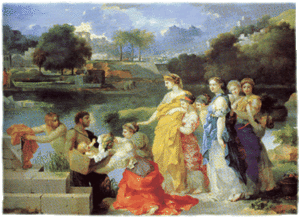
Sébastien Bourdon’s The Finding of Moses
As Norbert Elias has explained, the raison of court culture might better be translated “regulation”: it involves submission to the authority of tradition and etiquette (Elias, The Court Society 110-116).[21]See also Pocock, 12-13. Such acquiescence gained one entry into a neoplatonic realm that embodied timeless truths; it allowed one to luxuriate in an idyllic cocoon, a paradise on earth. By contrast, the premises of contemporaneous Italian music enacted ideals of progressive thought: the consistent sacrifice within the music of past and present for the sake of ongoing movement into the future. It is the Italian version of tonality that best approximates the restless habits of questioning, discarding, and projecting forward on the quest for distant goals that we identify with Enlightenment Reason. To the extent that images of extroverted public rhetoric, progressive action, and investment in the future circulated within Italian repertories, that music needed to be quarantined: French authorities feared that a bite of the forbidden sonata would suffice to destroy the illusion of their carefully cultivated Eden, to bring about another Fall from Grace. We can still experience in the musical practices of this time the radical incompatibility of these two worlds. To those courtiers who had managed to live suspended in music such as D’Anglebert’s, the head-on collision with the sweeping events of the later eighteenth century involved more than loss of status and wealth; it brought with it the violent collapse of a way of being. The hermetically sealed jar broke and history rushed in.
This helps explain the vehemence with which so many in France denounced Italian music. In his account of the hysteria over music generated during the Guerre des bouffons, d’Alembert presented the following satirical version of the argument against foreign styles:
All liberties are interrelated and are equally dangerous. Freedom in music entails freedom to feel, freedom to feel means freedom to act, and freedom to act means the ruin of states. So let us keep French opera as it is if we wish to preserve the kingdom and let us put a brake on singing if we do not want to have liberty in speaking to follow soon afterwards. (520; my translation)
Note d’Alembert’s use of breathless phrasing and his deployment of logic that, once unleashed, runs rampant from music to insurrection. The irony is, of course, that if Italian music itself did not bring about the French Revolution, it did embody quite palpably the qualities of motion and habits of thought that eventually overthrew the court tradition. In the words of José Maravall: “Static guidance controlling by presence had to give way before a dynamic guidance controlling by activity” (68). And given French ideals such as neoplatonic order, spiritual Quiet, Absolutist authority, and Arcadian timelessness, the awakening could not have been more rude.[22]Of course, this is not the only moment in history to have experienced such a collision. Americanists such as David Noble have identified a similar confrontation at the turn of the last century … Continue reading
Of course, seventeenth-century France also produced Descartes, who advocated the individual subject’s questioning and rejection of traditional authority in his famous slogan “Cogito, ergo sum” (I think, therefore I am). But that was an earlier time. Louis XIV effectively monopolized the terms of Descartes’s egocentricity with his “L’état, c’est moi!” (I am the State), according to which he became the supreme and only Subject. As Hoffmann puts it, the French nobility “were invited to desire their infinite subservience to the Other. It was a perfect dream of power […] where the disciple is always desiring the body of the master and is turned to stare, in the posture of admiration, at the place where the renunciation of his own will is performed. Reverie of another’s cogito” (34).
I have no intention of trying to lure anyone back to take up permanent habitation in the always-vulnerable, spellbound utopia of seventeenth-century France. But as historians of music, we need to be able to understand the goût, the plaisir, the raison that sustained this repertory: not only for the sake of performers, who must learn how to suspend their expectation of future-oriented procedures if they are to make sense of this music, but also for the sake of historians of culture, to whom we can offer invaluable pieces of a larger puzzle.
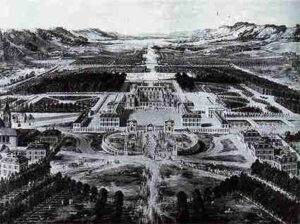
Versailles has long since become a theme park safe for bourgeois tourists. Perhaps we can afford the occasional surrender to absorption in D’Anglebert without losing our investment in upward mobility.[23]This essay was written for the national meeting of the American Musicological Society Meetings in Phoenix, November 1997, as part of a session on music in Absolutist France. I wish to thank Kate van … Continue reading
